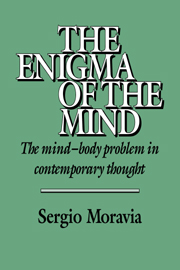Book contents
- Frontmatter
- Contents
- Preface to the English edition
- The enigma of the mind
- The enigma of the mind: Introduction to a metaphor
- 1 Toward a physical science of the mental: Feigl and the (re-)construction of the ‘mind–body problem’
- 2 The apogee of physicalism: The identity theory and materialism in the Australian school
- 3 The obscure relationship: Problems and debates surrounding the identity theory
- 4 Psychology as alchemy: The elimination of the mental in the ‘disappearance theory’
- 5 The mind as function: The functionalist approach to the mind–body problem
- 6 The mind as property and as event: The ‘reformist’ neo-identityism of Kim and Davidson
- 7 The mind as language: The linguistic turn in the mind–body problem
- 8 Speaking in many different ways: The pluralization of descriptions and explanations in the MBP
- 9 The mind as a mode of subjective experience: An interpretive model of the features of the mental
- 10 The mind as ‘subject’ and as ‘being-in-the-world’: Toward a non-mentalistic interpretation of the mental
- Appendix The mental as intentional/‘personal’ emergence: The psycho-personological perspective of Joseph Margolis
- Bibliography
- Name index
The enigma of the mind: Introduction to a metaphor
Published online by Cambridge University Press: 05 June 2012
- Frontmatter
- Contents
- Preface to the English edition
- The enigma of the mind
- The enigma of the mind: Introduction to a metaphor
- 1 Toward a physical science of the mental: Feigl and the (re-)construction of the ‘mind–body problem’
- 2 The apogee of physicalism: The identity theory and materialism in the Australian school
- 3 The obscure relationship: Problems and debates surrounding the identity theory
- 4 Psychology as alchemy: The elimination of the mental in the ‘disappearance theory’
- 5 The mind as function: The functionalist approach to the mind–body problem
- 6 The mind as property and as event: The ‘reformist’ neo-identityism of Kim and Davidson
- 7 The mind as language: The linguistic turn in the mind–body problem
- 8 Speaking in many different ways: The pluralization of descriptions and explanations in the MBP
- 9 The mind as a mode of subjective experience: An interpretive model of the features of the mental
- 10 The mind as ‘subject’ and as ‘being-in-the-world’: Toward a non-mentalistic interpretation of the mental
- Appendix The mental as intentional/‘personal’ emergence: The psycho-personological perspective of Joseph Margolis
- Bibliography
- Name index
Summary
Ein Weltknoten, a world knot: this is how Arthur Schopenhauer once defined the problem of the relationship between mind and body. This ‘knot’ ambiguously binds together what are, or appear to be, the two fundamental dimensions of man. This same knot, however, also calls up a series of figures, questions, and issues which extend well beyond the confines of the mind–body relationship. Not surprisingly, then, the relationship between the mental and the bodily is a theme which has pervaded the whole history of Western thought. It played a central role in ancient knowledge, especially among Aristotelians, and in the field of ancient medicine. It reemerged, in the most various forms, in the culture of the Middle Ages and in Renaissance humanism. We find it again at the center of seventeenth-century philosophy, from Descartes to Spinoza and Leibniz. It reappeared as the subject of a passionate debate in the Age of Enlightenment, and not only within the medical milieu, one of my preferred haunts. The mbp went on to occupy much of nineteenth-century thought, both philosophical and scientific, as is clear from its central role in the works of Maine de Biran, Alexander Bain, Bergson, James, and many German psychologists and philosophers. Finally, in our century the question has continued to spark intense theoretical interest, even among followers of such divergent currents as neopositivism and phenomenology, to name only two.
- Type
- Chapter
- Information
- The Enigma of the MindThe Mind-Body Problem in Contemporary Thought, pp. 1 - 29Publisher: Cambridge University PressPrint publication year: 1995



